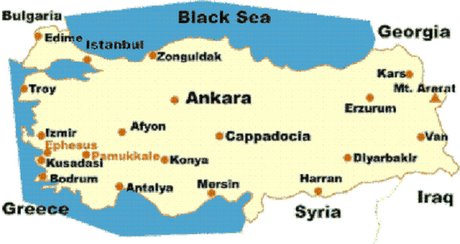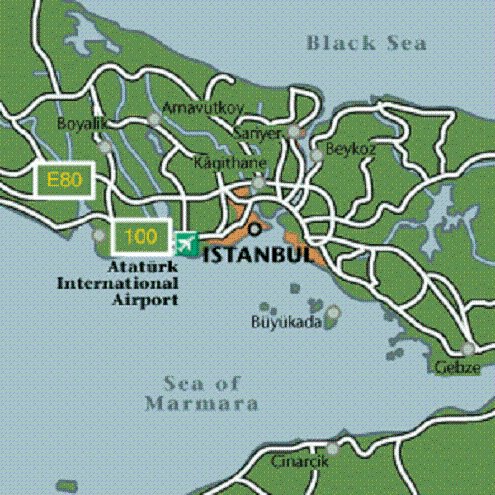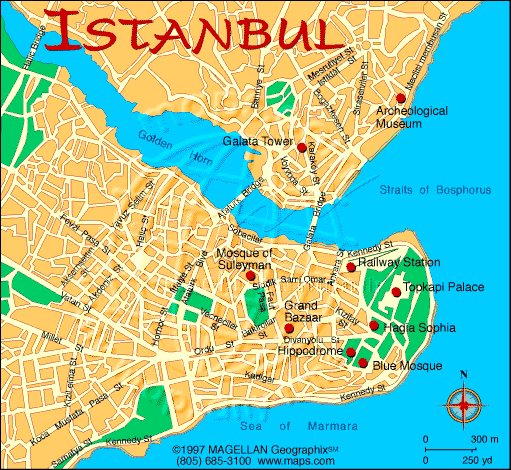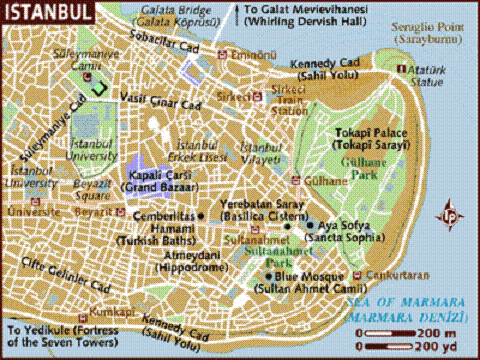 Topkapı Palace constructed by Fatih Sultan Mehmet, (the Conqueror) in 1478 has been the official residence of the Otoman Sultans and center of State Administration around 380 years until the construction of Dolmabahçe Palace by Sultan Abdülmecid. The palace having around 700.000 m.² area during the foundation years has currently 80.000 m.² area. Topkapı Palace was evacuated by the accommodation of the Palace inhabitants in Dolmabahçe, Yıldız and in other palaces. Upon abandoning by the Sultans, Topkapı Palace where many officials resided had also never lost its importance.
Topkapı Palace constructed by Fatih Sultan Mehmet, (the Conqueror) in 1478 has been the official residence of the Otoman Sultans and center of State Administration around 380 years until the construction of Dolmabahçe Palace by Sultan Abdülmecid. The palace having around 700.000 m.² area during the foundation years has currently 80.000 m.² area. Topkapı Palace was evacuated by the accommodation of the Palace inhabitants in Dolmabahçe, Yıldız and in other palaces. Upon abandoning by the Sultans, Topkapı Palace where many officials resided had also never lost its importance.  The palace was repaired from time to time. A special attention was taken for the annual maintenance of Mukaddes Emanetler Dairesi (Sacred Safekeeping Rooms) visited by the sultan and his family during Ramadan. The opening of Topkapı Palace for visits as museum happened firstly in the reign of Sultan Abdülmecid (1839-1861). The belongings within Topkapı Palace Treasury was shown to the contemporary English ambassador. Later on, it has become a tradition to show the antics within the Topkapı Palace Treasury to the foreigners and during the era of Sultan Abdulaziz (1861-1876), showrooms are made in French style, and these antics are started to be shown to foreigners in these showrooms within Treasury. During the period when Sultan II Abdulhamid was dethroned (1876-1909), it was thought to open the Treasury Room to public visits on Sundays and Tuesdays, yet it never realized.
The palace was repaired from time to time. A special attention was taken for the annual maintenance of Mukaddes Emanetler Dairesi (Sacred Safekeeping Rooms) visited by the sultan and his family during Ramadan. The opening of Topkapı Palace for visits as museum happened firstly in the reign of Sultan Abdülmecid (1839-1861). The belongings within Topkapı Palace Treasury was shown to the contemporary English ambassador. Later on, it has become a tradition to show the antics within the Topkapı Palace Treasury to the foreigners and during the era of Sultan Abdulaziz (1861-1876), showrooms are made in French style, and these antics are started to be shown to foreigners in these showrooms within Treasury. During the period when Sultan II Abdulhamid was dethroned (1876-1909), it was thought to open the Treasury Room to public visits on Sundays and Tuesdays, yet it never realized.
By the order of Ghazi Mustafa Kemal Atatürk, Topkapı Palace firstly affiliated to the Istanbul Asar-ı Atika Museums Directorate and opened to public visits on date of April 3, 1924, then it started to service as Treasury Chamberlain, after it was renamed as Treasury Directorate and finally it was renamed as Topkapı Palace Museum Directorate and it still continues its services. Upon the performance of small repairs and taking some administrative cautions in 1924, Topkapı Palace was opened to service as a Museum on October 9, 1924. The sections opened to visit at that time were Kubbealtı, Arz Odası, Mecidiye Köşkü (Pavilion Mecidiye), Hekimbaşı Odası (Room of Chief Doctor), Mustafa Paşa Köşkü (Pavilion Mustafa Pasha) ve Bağdad Köşkü’dür (Pavilion Baghdad).
Istanbul-Constantinople Tour
The historic city of Istanbul forms a unified whole with the Bosphorus and the Golden Horn. Nowhere else can one find the wonders of nature, human artifacts, the testimony of the past and the bustle of everyday life in such close relationship. For those who will remain briefly in the city, there are day tours including the important historical sites, museums, the famous Covered Bazaar and its vicinity. These tours leave from the hotels or the port and visit the masterpieces on the historical promontory in half-day programs. The important sites are the Hagia Sophia, one of Galata Tower from which one can see the best view of the city; the Dolmabahce Palace on the Bosphorus, the richest palace in the world; the famous Archeological Museums; the Turkish and Islamic Art Museum; the Spice Bazaar, and many other historical sites. The performances of belly dancers and folk dancers add color to night tours. The air and seaports of Istanbul are located on the European side. For those who have never stepped on Asian soil before, a boat trip or the bridges over the Bosphorus offer a wonderful opportunity. Over the suspension bridges and from Great Camhca Hill on the Asian side, one can get a bird's eye view of the city and the Bosphorus.The Princes' Islands, one hour by ferryboat and the eight wonders of the world, the Suleymaniye Mosque, Sultan Ahmet Mosque, the Hippodrome and the Topkapi Palace Museum. This is the classical one-day tour, but there are many specialized tours for Roman, Byzantine and Turkish monuments, the Bosphorus or the Asian shores, which will make the visitor return to his country with unforgettable memories. Minimums of three or four days are necessary to really get to know Istanbul.
These should include a visit to the Roman city walls; the well-known Kariye Museum decorated with late Byzantine frescoes and mosaics; half an hour by catamarans from the city center, are ideal places for relaxation, recreation, hiking, swimming or phaeton tours. In addition to the city tours offered by travel agencies, luxury limousine services are also available for tours. Shopping opportunities are many and varied in Istanbul. The Covered Bazaar and the well-known shops at its entrance, Akmerkez, Galeria, Capitol and similar malls, the designer boutiques in Beyoglu and Nisantasi, and the stores on Bagdat Avenue are open the whole year.
 Topkapı Palace constructed by Fatih Sultan Mehmet, (the Conqueror) in 1478 has been the official residence of the Otoman Sultans and center of State Administration around 380 years until the construction of Dolmabahçe Palace by Sultan Abdülmecid. The palace having around 700.000 m.² area during the foundation years has currently 80.000 m.² area. Topkapı Palace was evacuated by the accommodation of the Palace inhabitants in Dolmabahçe, Yıldız and in other palaces. Upon abandoning by the Sultans, Topkapı Palace where many officials resided had also never lost its importance.
Topkapı Palace constructed by Fatih Sultan Mehmet, (the Conqueror) in 1478 has been the official residence of the Otoman Sultans and center of State Administration around 380 years until the construction of Dolmabahçe Palace by Sultan Abdülmecid. The palace having around 700.000 m.² area during the foundation years has currently 80.000 m.² area. Topkapı Palace was evacuated by the accommodation of the Palace inhabitants in Dolmabahçe, Yıldız and in other palaces. Upon abandoning by the Sultans, Topkapı Palace where many officials resided had also never lost its importance.  The palace was repaired from time to time. A special attention was taken for the annual maintenance of Mukaddes Emanetler Dairesi (Sacred Safekeeping Rooms) visited by the sultan and his family during Ramadan. The opening of Topkapı Palace for visits as museum happened firstly in the reign of Sultan Abdülmecid (1839-1861). The belongings within Topkapı Palace Treasury was shown to the contemporary English ambassador. Later on, it has become a tradition to show the antics within the Topkapı Palace Treasury to the foreigners and during the era of Sultan Abdulaziz (1861-1876), showrooms are made in French style, and these antics are started to be shown to foreigners in these showrooms within Treasury. During the period when Sultan II Abdulhamid was dethroned (1876-1909), it was thought to open the Treasury Room to public visits on Sundays and Tuesdays, yet it never realized.
The palace was repaired from time to time. A special attention was taken for the annual maintenance of Mukaddes Emanetler Dairesi (Sacred Safekeeping Rooms) visited by the sultan and his family during Ramadan. The opening of Topkapı Palace for visits as museum happened firstly in the reign of Sultan Abdülmecid (1839-1861). The belongings within Topkapı Palace Treasury was shown to the contemporary English ambassador. Later on, it has become a tradition to show the antics within the Topkapı Palace Treasury to the foreigners and during the era of Sultan Abdulaziz (1861-1876), showrooms are made in French style, and these antics are started to be shown to foreigners in these showrooms within Treasury. During the period when Sultan II Abdulhamid was dethroned (1876-1909), it was thought to open the Treasury Room to public visits on Sundays and Tuesdays, yet it never realized. 






